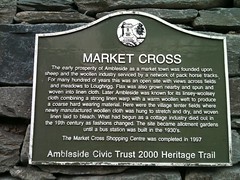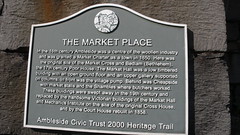Market Cross, Ambleside
Commemorated on 2 plaques
Market Cross. The early prosperity of Ambleside as a market town was founded upon sheep and the woollen industry serviced by a network of pack horse tracks. For many hundred of years this was an open site with views across fields and meadows to Loughrigg. Flax was also grown nearby and spun and woven into linen cloth. Later Ambleside was known for its linsey-woolsey cloth combining a strong linen warp with a warm woollen weft to produce a coarse hard wearing material. Here were the village tenter fields where a newly manufactured woollen cloth was hung to stretch and dry, and woven linen laid to bleach. What had begun as a cottage industry died out in the 19th century as fashions changed. The site became allotment gardens until a bus station was built in the 1930's. The Market Cross Shopping Centre was completed in 1997.
Market Cross, Ambleside, United Kingdom where it sited
The Market Place. In the 16th century Ambleside was a centre of the woollen industry and was granted a Market Charter as a town in 1650. Here was the original site of the Market Cross and Bedlam (Bethlehem), the 17th century Poor House. The Market Hall was a low timbered building with an open ground floor and an upper gallery supported on columns. In front was the village pump. Behind was Cheapside with market stalls and the Shambles where butchers worked. These buildings were swept away in the 18th century and replaced by the handsome Victorian buildings of the Market Hall and Mechanics Institute on the site of the original Cross House, and by the Court House rebuilt in 1868.
Market Place, Ambleside, United Kingdom where it sited


